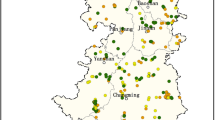Abstract
Soils contaminated with heavy metals may pose a threat to environment and human health if metals enter the food chain over and above threshold levels. In general, there is a lack of information on the presence of heavy metals in tea [Camellia sinensis (L). O. Kuntze] plants and the soils in which they are grown. Therefore, an attempt was made to establish a database on the important heavy metals: cadmium (Cd), chromium (Cr), nickel (Ni), and lead (Pb). For an initial survey on heavy metals, soil samples were collected randomly from tea-growing areas of Tamil Nadu, Kerala, and Karnataka, India. Parallel studies were conducted in the greenhouse on uptake of Pb, Cd, and Ni from soils supplemented with these metals at different concentrations. Finally, metal distribution in the tea plants under field conditions was also documented to assess the accumulation potential and critical limit of uptake by plants.
Similar content being viewed by others

References
Adriano, D. C. (2001). Trace elements in terrestrial environment (2nd ed.). New York: Springer-Verlag, New York, Inc.
Alloway, B. J. (1995). Heavy metals in soil (2nd ed.). Glasgow: Blackie Academic and Professional.
AOAC. (2005). Official methods of analysis of AOAC international (18th ed.). Rockville, MD: AOAC International.
Bhargava, B. S., & Raghupathi, H. B. (2001). Analysis of plant materials for macro and micronutrients. In H. L. S. Tandon (Ed.), Methods of analysis of soils, plants, waters and fertilizers (pp. 49–82). New Delhi: Fertiliser Association and Consultation Organization.
Bettinelli, M., Baffi, C., Beone, G. M., & Spezia, S. (2000). Soil and sediment analysis by spectroscopic techniques part I: determination of Cd, Co, Cr, Cu, Mn, Ni, Pb and Zn. Atomic Spectroscopy, 21(2), 50–59.
Han, W. Y., Zhao, F. J., Shi, Y. Z., Ma, L. F., & Ruan, J. Y. (2006). Scale and causes of lead contamination in Chinese tea. Environmental Pollution, 139, 125–132.
Jin, C. W., Zheng, S. J., He, Y. F., Zhou, G. D., & Zhou, Z. X. (2005). Lead contamination in tea garden soils and factors affecting its bioavailability. Chemosphere, 59, 1151–1159.
Kabata-Pendias, A., & Pendias, H. (1991). Trace elements in plants. In Trace elements in soils and plants (2nd ed., pp. 67–85). Boca Raton: CRC Press.
Kabata-Pendias, A., & Pendias, H. (1992). Trace elements in soils and plants (2nd ed., p. 365). Boca Raton: Lewis Publishers.
Kabata-Pendias, A. (2000). Trace elements in soils and plants (3rd ed.). Boca Raton: CRC Press.
Lambert, M., Pierzynski, G., Erickson, L., & Schnoor, J. (1997). Remediation of lead, zinc, and cadmium contaminated soils. In R. Hester & R. Harrison (Eds.), Contaminated land and its reclamation (pp. 91–102). Cambridge: the Royal Society of Chemistry.
McLaughlin, M. J., Tiller, K. G., Naidu, R., & Stevens, D. P. (1996). Review: the behaviour and environmental impact of contaminants in fertilizers. Australian Journal of Soil Resarch, 34, 1–54.
Mengel, K., & Kirkby, E. A. (1987). Principles of plant nutrition (4th ed., pp. 520–563). Bern: IPI Pub.
Natesan, S., & Ranganathan, V. (1990). Content of various elements in different parts of the tea plant and in infusions of black tea from southern India. Journal of the Science of Food and Agriculture, 51, 125–139.
Pendias, A. K. (2004). Soil-plant transfer of trace elements—an environmental issue. Geoderma, 122, 143–149.
Perkin-Elmer. (2000). Analytical methods for atomic absorption spectrometry. 0303-0152, E.
Ranganathan, V., & Natesan, S. (1985). Potassium nutrition in tea. In Potassium in Agriculture (pp. 981–1022). Madison: ASA-CSSA-SSSA, Wisconsin.
Seenivasan, S., Manikandan, N., & Muraleedharan, N. (2008). Chromium contamination in black tea and its transfer into tea brew. Food Chemistry, 106, 1066–1069.
Shi, Y. Z., Ruan, J. Y., Ma, L. F., Han, W. Y., & Wang, F. (2008). Accumulation and distribution of arsenic and cadmium by tea plants. Journal of Zhejiang University. Science. B, 9(3), 265–270.
Vaselli, O., Bucccianti, A., & De-Siena, C. (1997). Geochemical characterization of ophiolithic soils in a temperate climate: a multivariate statistical approach. Geoderma, 75, 117–133.
Venkatesan, S. (2007). Notes and amendments to the recommendations on manuring of tea in south India (Section 11. In: Handbook of tea culture). Valparai: UPASI Tea Research Institute.
Verma, D. P., & Palani, N. (1995). Phosphorous nutrition for sustained tea productivity in south India. Bulletin of UPASI Tea Scientific Department, 48, 47–58.
Verma, D. P. (1995). Magnesium nutrition of tea. Newsletter of UPASI Tea Research Institute, 5, 3.
Verma, D. P., & Palani, N. (1997). Manuring of tea in south India (revised recommendations). Valparai: UPASI Tea Research Institute.
Acknowledgements
The authors are grateful to the Tea Board, Government of India, for the financial assistance for this work under the X 5-year plan.
Author information
Authors and Affiliations
Corresponding author
Rights and permissions
About this article
Cite this article
Seenivasan, S., Anderson, T.A. & Muraleedharan, N. Heavy metal content in tea soils and their distribution in different parts of tea plants, Camellia sinensis (L). O. Kuntze. Environ Monit Assess 188, 428 (2016). https://doi.org/10.1007/s10661-016-5440-y
Received:
Accepted:
Published:
DOI: https://doi.org/10.1007/s10661-016-5440-y


